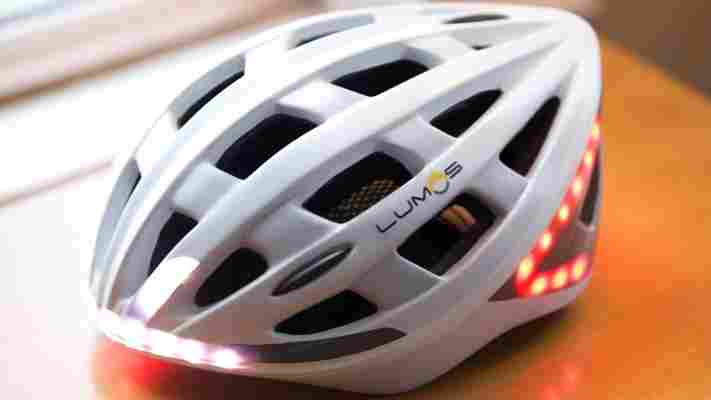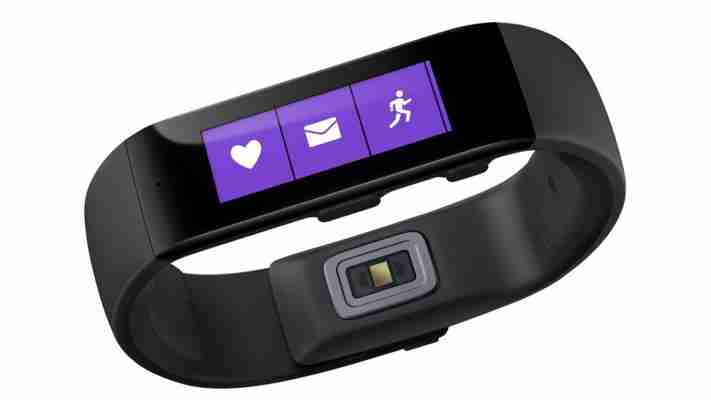If you’re a city cyclist, or indeed an rural road warrior, you’ll already know that taking to your bike is a perilous pursuit – even if all you’re trying to do is get to work.

In an effort to redress the safety balance somewhat, Lumos is launching a Kickstarter campaign looking to raise $125,000 for its helmet with integrated lights and flashing indicators.
You control the indicators via a small wireless remote that can be attached to your handlebars. Brake lights automatically activate when the accelerometer in the helmet detects that you are slowing down.
Battery life is stated at around one week, based on an average of using the helmet for about 30 minutes each day, and it’s water-resistant and has a micro-USB for charging.
Most importantly though, it’s still designed to be a regular ol’ protective helmet too, conforming to US and European safety ratings.
‘Super Early bird’ backers can reserve one of the first batch of Lumos helmets for $85, with the price rising to $99 and then $119 as each tier sells out. The first batch is due to ship in April, with subsequent orders to follow along in June 2016.
➤ Lumos – A Next Generation Bicycle Helmet [Kickstarter]
Read next: Crowdfunding darling Dot lands on Indiegogo after being suspended from Kickstarter
Microsoft Band available to buy in the UK now for £170
Microsoft’s wearable Band device that plugs into the Microsoft Health service to allow users to keep track of things like activity, heart rate, sun exposure, stress levels, calories burned and quality of sleep is now available to buy in the UK for the first time.

In addition to the activity tracking side of things, the device – via its companion apps for Windows Phone , iOS and Android devices – offers tailored workouts depending on your own specific goals and will do things like map your training routes via GPS, or allow you to set commands using Cortana.
The band is available to buy for around £170 in the UK from retailers like Amazon, Currys PC World, Dixons Travel, Harrods, Microsoft Store and O2. It first went up for pre-order in the country last month , but Microsoft hasn’t said how many units were reserved.
➤ Microsoft Band and Health arrive in the UK [Microsoft]
MOS Go review: MacBook power on the run (with one big catch)
True portability for laptops is probably near its peak. Battery life improves each year, and computers charge quickly. In those rare moments you can’t (or won’t) find an outlet, a battery pack would be useful.

The MOS Go is such a thing , with 12,000mAh of juice and USB-C connectivity. It promises to charge your computer and mobile devices while on the run, but there are a few drawbacks.
Go is one of the more attractive battery packs we’ve seen. An aluminum shell helps it look like it belongs next to your snappy new computer, and it’s fairly svelte.
One side has two USB-C ports (one in, one out) and a standard USB ‘out’ port with four status lights so you know how much is left in the power bank.
In use, the MOS Go charged a 2016 MacBook to 65 percent from absolute scratch in about the same time it takes while plugged in (during light use). That’s not bad, but it’s also not reason enough to get excited.
Unfortunately, the Go also lets off a lot of heat when in use. It wasn’t too hot to touch, but I’d resist carrying it in-hand for longer than ten seconds or so. Aluminum looks pretty, but disperses heat everywhere.
You also don’t get a cable with your order. MOS has some incredible Spring cables that are nearly indestructible, but there’s no USB-C model . You’re left shopping for one ( I recommend this Aukey model ) or using the USB-C cable Apple gave you with the MacBook.
It’s hard to argue in favor of the Go, especially if you’ve got more than one USB-C device.
While it’s pretty and powerful, I’d gladly trade space in my bag for a larger pack that could charge my MacBook fully. If the goal is to leave the charger at home — as it should be with any power pack — I want a full recharge.
The lack of a USB-C cable really hurts this one, too. I’m not sure why MOS decided to sell a battery pack without a cable. It’s counterintuitive. The company definitely should have made a USB-C Spring cable, which are excellent.
Charging the MOS Go is also clumsy; its only inlet is USB-C, which means you’ll have to use your Apple charger and cable. If you’ve got an Android phone using USB-C (and a MacBook), you may already have a more portable charger — but the overlap on that Venn diagram is likely really small.
MOS Go is good for the MacBook — and better for mobile — but not a winner. You can get more powerful banks for less money (the Go is $ 119.99 ) to use with mobile devices, and charging to 65 percent while leaving me to find my own cable is more annoying than finding an outlet.
